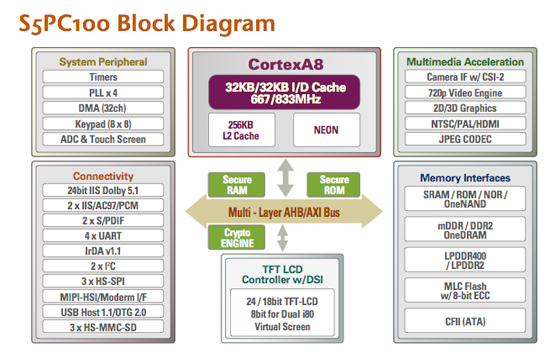The iPhone 3GS Hardware Exposed & Analyzed
by Anand Lal Shimpi on June 10, 2009 12:00 AM EST- Posted in
- Smartphones
- Mobile
Enter the ARM Cortex A8
This past weekend Palm introduced its highly anticipated Pre. While I’m still working on my review of the Pre, I can say that it’s the closest thing to an iPhone since Apple first unveiled the product two summers ago. In many ways the Pre is lacking in areas that the iPhone has honestly perfected, but in others the Pre easily surpasses Apple’s best.
One such area is raw performance. While both the iPhone and iPhone 3G use the same old CPU/GPU, the Pre uses TI’s OMAP 3430 processor. The 3430, like the SoC Apple uses, has both a CPU and GPU on the same package. Instead of the ARM11 and the PowerVR MBX-Lite however, the OMAP 3430 uses an ARM Cortex A8 core and a PowerVR SGX GPU. Both are significant improvements over what was in the original iPhone.
Thankfully, Apple fans don’t have to be outclassed for long - the newly announced iPhone 3GS uses a comparable CPU/GPU pair.
Although unannounced, the iPhone 3GS uses (again) a Samsung SoC but this time instead of the ARM11 + MBX-Lite combo it’s got a Cortex A8 and PowerVR SGX; just like the Pre.

A derivative of this is what you'll find in the iPhone 3GS
If the ARM11 is like a modern day 486 with a very high clock speed, the Cortex A8 is like a modern day Pentium. The A8 lengthens the integer pipeline to 13 stages, enabling its 600MHz clock speed (what I’m hearing the 3GS runs at). The Cortex A8 also widens the processor; the chip is now a two-issue in-order core, capable of fetching, decoding and executing two RISC instructions in parallel.
The ARM11 processor in the iPhone/iPhone 3G has a basic vector floating point unit, but the A8 adds a much more advanced SIMD engine called NEON. The A8 also has twice as many double precision FP registers as the ARM11. The addition of NEON and the improved vector FPU in the A8 makes the processor much less like the original Pentium and much more like Intel’s Atom. Granted, Atom is significantly faster than the A8, but it also draws much more power.
Caches also get a significant improvement. I believe Apple will be using a derivative of Samsung’s S5PC100, which has a 32KB/32KB L1 cache (I/D, we may see a 16KB/16KB config instead) and a 256KB L2 cache. The L2 cache, as you’ll remember from the first section, is a new addition to the A8; the ARM11 core didn’t have an L2.
| iPhone 3G (ARM11) | iPhone 3GS (ARM Cortex A8) | |
| Manufacturing Process | 90nm | 65nm |
| Architecture | In-Order | In-Order |
| Issue Width | 1-issue | 2-issue |
| Pipeline Depth | 8-stage | 13-stage |
| Clock Speed | 412MHz | 600MHz |
| L1 Cache Size | 16KB I-Cache + 16KB D-Cache | 32KB I-Cache + 32KB D-Cache |
| L2 Cache Size | N/A | 256KB |
The combination of higher clock speeds, more cache and a dual-issue front end results in a much faster processor. Apple claims the real world performance of the iPhone 3GS can be up to 2x faster than the iPhone 3G, and I believe that’s quite feasible.

The new SoC is built on a 65nm manufacturing process, down from 90nm in the original hardware. However, power consumption should still be higher for the new SoC compared to the old one. ARM’s own site lists ~0.25mW per MHz for the ARM11 core but < 0.59mW per MHz for the A8. That’s for a 650MHz low power A8 core and I’m expecting 600MHz for the 3GS, that’s at most 3x the power consumption of the CPU in the original iPhone. So how can Apple promise better battery life?
The thing about these comparisons is that they don’t show the full picture. With the same battery capacity, running at full speed, the new iPhone 3GS would run out of juice faster than the existing iPhone 3G. But that’s rarely how people use their phones. Chances are that you’ll perform a few tasks before putting the phone back to sleep, and what matters then is how quickly you can complete those tasks.
Just under nine years ago Intel talked about a technology called Quick Start. Let me quote from our IDF 2000 Day 2 coverage (wow, that was a while ago):
“"Intel has figured out that it is best to use full CPU power for a split second to finish a task and then put the CPU to idle as this conserves battery life the best. Although one may suspect that when running complex operations the CPU would not have time to go idle, this is not the case. To illustrate this point, Intel used an example of DVD playback. Very stressful on the system as a whole, Intel's quick start technology allows the CPU to "hurry up" and perform the DVD decoding operations and then go idle until the frame is displayed to screen and the next scene needs to be calculated. This saves battery life because, although the system may require 3 watts or so to "hurry up", the power consumption goes down near .25 watts when idle. By averaging these two numbers, one can quickly see how quick start can extend battery life."”
The A8’s power consumption has to be well under that 3x max I quoted above, and the iPhone 3GS needs to be more than just 2x faster at executing instructions, but if possible then it’s quite feasible for the faster A8 to draw more instantaneous power but draw less power on average than the ARM11 core in the original iPhone.










65 Comments
View All Comments
HelToupee - Wednesday, June 10, 2009 - link
There's been one in the works for more than a year. (http://www.icontrolpad.com/)">http://www.icontrolpad.com/) They've been stalling, though, and apple's releasing of new models every year is hurting, too. They originally were just aiming for jailbroken phones / ipods, but now want to enable full SDK support. I have cash set aside to buy one, if they'd just put them on sale...mesiah - Wednesday, June 10, 2009 - link
Glad to see someone is working on this. From the video on the sight it looks like the latency on the controls is kind of an issue, and it looked like it wouldn't accept multiple button presses at the same time i.e. forward and right simultaneously. Could just be an issue with the way the interface with the iphone works, although the multiple button thing could just be me :P also, would like to see an analog stick. The days of on/off style movement controls are long gone.Lonyo - Wednesday, June 10, 2009 - link
They've had the iPhone, and the iPhone 3G.They've sold quite a lot of them, using the same hardware.
Now they are releasing a new product with faster hardware.
Palm has the Pre, it has faster hardware.
The problem here is that either Apple developers are going to have to develop for the (s)lowest common denominator (20million units), and either risk annoying customers by making them unable to use the stuff/forcing them to upgrade, or making applications which aren't sa impressive as they could be.
The Pre has the advantage of being out later, so everything has the same base point (although it has no install base or history yet).
While it's good Apple have improved their hardware, it will be interesting to see how the handle the software side (after all, they have been forcing programs to be forwards compatible with something which was unreleased at the time - OS3.0).
Apple could be their own worst enemy with this faster hardware, and they have been seen to drop legacy support quite quickly already (Snow Leopard anyone?), things that other people can't get away with.
str1f3 - Wednesday, June 10, 2009 - link
The problem with the Pre is that it's not meant for gaming. The SDK is only HTML and Javascript. There won't be any serious gaming on it. In the mobile phone area Apple is pretty much to themselves.Shadowself - Wednesday, June 10, 2009 - link
Actually, I don't mind that Snow Leopard is going to be Intel only. With it coming out in September I would not suggest that anyone other than the bleeding edge crowd upgrade to Snow Leopard until October or November at the earliest. That makes the oldest Intel based Mac almost four years old.If I were still running G4s or G5s (PowerPC based) systems as of this coming November I clearly don't *need* the performance enhancements of a full 64-bit kernel and drivers, OpenCL or Grand Central Dispatch.
While Leopard had nearly as shaky/buggy a start as Vista (though 99.9% of Mac users won't admit it), Leopard has reportedly morphed into a very stable and serviceable system. If you're keeping your Mac for 5+ years, sticking with Leopard might be a great option.
sc3252 - Wednesday, June 10, 2009 - link
I think I read somewhere that developers for the Ipod would put in options to enable for the faster models. So you just check the box if you have a faster cpu and you get the cooler looking graphics.Pirks - Wednesday, June 10, 2009 - link
The day WoW comes to iPhone is the day when I gonna buy the little bastard. I guess this will happen next year or so. I can almost hear Blizzard devs steaming away, downloading iPhone SDK and buyng more and more Macs. This thing is gonna freakin ROCK.sc3252 - Wednesday, June 10, 2009 - link
Not now. The gpu and CPU are still way to slow to play anything like world of Warcraft, just look at some of the demos of the openpandora which uses the same CPU/GPU combo, it runs quake 3 around 22fps from what I can see and most of us now how much of a pushover that game is.I would expect that the next generation omap 4 might be able to run it being a dual core 1Ghz, but I would think it would still need a faster GPU. Also you have to imagine trying to play a game like world of warcraft with those controls, it would be terrible. You might see a game like eve do it since the game developers are very forward thinking, but not Activision blizzard.
Digitalhell - Wednesday, July 8, 2009 - link
I've never seen Quake3 compiled for CortexA8 and OGL 2.0ES. The best Q3 currently available is actually designed for TI Omap 2/Samsung 6400 which are based on Arm11 processor core and Ogl 1.1 ES.monomer - Wednesday, June 10, 2009 - link
While I don't see Blizzard releasing a mobile version of WoW anytime soon, just imagine the amount of time you could waste if they simply released an Auction House app.